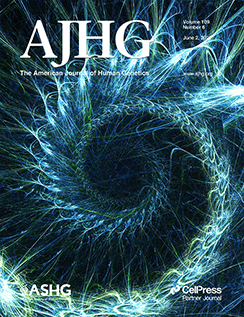Heterozygous UBR5 variants result in a neurodevelopmental syndrome with developmental delay, autism, and intellectual disability.
IF 8.1
1区 生物学
Q1 GENETICS & HEREDITY
引用次数: 0
Abstract
E3 ubiquitin ligases have been linked to developmental diseases including autism, Angelman syndrome (UBE3A), and Johanson-Blizzard syndrome (JBS) (UBR1). Here, we report variants in the E3 ligase UBR5 in 29 individuals presenting with a neurodevelopmental syndrome that includes developmental delay, autism, intellectual disability, epilepsy, movement disorders, and/or genital anomalies. Their phenotype is distinct from JBS due to the absence of exocrine pancreatic insufficiency and the presence of autism, epilepsy, and, in some probands, a movement disorder. E3 ubiquitin ligases are responsible for transferring ubiquitin to substrate proteins to regulate a variety of cellular functions, including protein degradation, protein-protein interactions, and protein localization. Knocking out ubr-5 in C. elegans resulted in a lower movement score compared to the wild type, supporting a role for UBR5 in neurodevelopment. Using an in vitro autoubiquitination assay and confocal microscopy for the human protein, we found decreased ubiquitination activity and altered cellular localization in several variants found in our cohort compared to the wild type. In conclusion, we found that variants in UBR5 cause a neurodevelopmental syndrome that can be associated with a movement disorder, reinforcing the role of the UBR protein family in a neurodevelopmental disease that differs from previously described ubiquitin-ligase-related syndromes. We also provide evidence for the pathogenic potential loss of UBR5 function with functional experiments in C. elegans and in vitro ubiquitination assays.杂合的UBR5变异导致发育迟缓、自闭症和智力残疾的神经发育综合征。
E3泛素连接酶与发育性疾病有关,包括自闭症、Angelman综合征(UBE3A)和johnson - blizzard综合征(JBS) (UBR1)。在这里,我们报告了29例神经发育综合征患者的E3连接酶UBR5变异,这些神经发育综合征包括发育迟缓、自闭症、智力残疾、癫痫、运动障碍和/或生殖器异常。由于缺乏外分泌胰腺功能不全和存在自闭症、癫痫,并且在一些先证者中存在运动障碍,因此其表型与JBS不同。E3泛素连接酶负责将泛素转移到底物蛋白,以调节多种细胞功能,包括蛋白质降解,蛋白质-蛋白质相互作用和蛋白质定位。与野生型相比,敲除秀丽隐杆线虫中的UBR5会导致较低的运动评分,这支持了UBR5在神经发育中的作用。使用体外自泛素化实验和共聚焦显微镜检测人类蛋白,我们发现与野生型相比,在我们的队列中发现的几种变体中泛素化活性降低,细胞定位改变。总之,我们发现UBR5的变异导致与运动障碍相关的神经发育综合征,强化了UBR蛋白家族在不同于先前描述的泛素连接酶相关综合征的神经发育疾病中的作用。我们还通过秀丽隐杆线虫的功能实验和体外泛素化分析提供了UBR5功能潜在致病性丧失的证据。
本文章由计算机程序翻译,如有差异,请以英文原文为准。
求助全文
约1分钟内获得全文
求助全文
来源期刊
CiteScore
14.70
自引率
4.10%
发文量
185
审稿时长
1 months
期刊介绍:
The American Journal of Human Genetics (AJHG) is a monthly journal published by Cell Press, chosen by The American Society of Human Genetics (ASHG) as its premier publication starting from January 2008. AJHG represents Cell Press's first society-owned journal, and both ASHG and Cell Press anticipate significant synergies between AJHG content and that of other Cell Press titles.

 求助内容:
求助内容: 应助结果提醒方式:
应助结果提醒方式:


